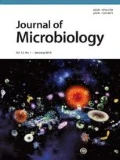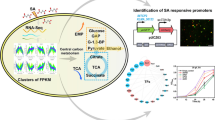Abstract
Response regulator (RR) is known a protein that mediates cell’s response to environmental changes. The effect of RR from extremophiles was still under investigation. In this study, response regulator homologs were mined from NGS data of Antarctic bacteria and overexpressed in Escherichia coli. Sixteen amino acid sequences were annotated corresponding to response regulators related to the two-component regulatory systems; of these, 3 amino acid sequences (DRH632, DRH1601 and DRH577) with high homology were selected. These genes were cloned in pRadGro and expressed in E. coli. The transformant strains were subjected to various abiotic stresses including oxidative, osmotic, thermal stress, and acidic stress. There was found that the robustness of E. coli to abiotic stress was increased in the presence of these response regulator homologs. Especially, recombinant E. coli overexpressing drh632 had the highest survival rate in oxidative, hypothermic, osmotic, and acidic conditions. Recombinant E. coli overexpressing drh1601 showed the highest tolerance level to osmotic stress. These results will be applicable for development of recombinant strains with high tolerance to abiotic stress.
Similar content being viewed by others
References
Altuvia, S., Weinstein-Fischer, D., Zhang, A., Postow, L., and Storz, G. 1997. A small, stable RNA induced by oxidative stress: role as a pleiotropic regulator and antimutator. Cell90, 43–53.
Andrews, S.C., Robinson, A.K., and Rodríguez-Quiñones, F. 2003. Bacterial iron homeostasis. FEMS Microbiol. Rev.27, 215–237.
Appukuttan, D., Singh, H., Park, S.H., Jung, J.H., Jeong, S., Seo, H.S., Choi, Y.J., and Lim, S. 2015. Engineering synthetic multi-stress tolerance in Escherichia coli using a deinococcal response regulator, DR1558. Appl. Environ. Microbiol.82, 1154–1166.
Basak, S. and Jiang, R. 2012. Enhancing E. coli tolerance towards oxidative stress via engineering its global regulator cAMP receptor protein (CRP). PLoS One7, e51179.
Blanchard, J.L., Wholey, W.Y., Conlon, E.M., and Pomposiello, P.J. 2007. Rapid changes in gene expression dynamics in response to superoxide reveal SoxRS-dependent and independent transcriptional networks. PLoS One2, e1186.
Calhoun, L. and Kwon, Y. 2011. Structure, function and regulation of the DNA-binding protein Dps and its role in acid and oxidative stress resistance in Escherichia coli: a review. J. Appl. Microbiol.110, 375–386.
Castanie-Cornet, M.P., Penfound, T.A., Smith, D., Elliott, J.F., and Foster, J.W. 1999. Control of acid resistance in Escherichia coli. J. Bacteriol.181, 3525–3535.
Chattopadhyay, M.K. 2002. Low temperature and oxidative stress. Curr. Sci.83, 109.
Chiang, S.M. and Schellhorn, H.E. 2012. Regulators of oxidative stress response genes in Escherichia coli and their functional conservation in bacteria. Arch. Biochem. Biophys.525, 161–169.
Choi, S.H., Baumler, D.J., and Kaspar, C.W. 2000. Contribution of dps to acid stress tolerance and oxidative stress tolerance in Escherichia coli O157: H7. Appl. Environ. Microbiol.66, 3911–3916.
D’Amico, S., Collins, T., Marx, J.C., Feller, G., and Gerday, C. 2006. Psychrophilic microorganisms: challenges for life. EMBO Rep.7, 385–389.
De Maayer, P., Anderson, D., Cary, C., and Cowan, D.A. 2014. Some like it cold: understanding the survival strategies of psychrophiles. EMBO Rep.15, 508–517.
Debabov, V. 2015. Modern approaches to the creation of industrial microorganism strains. Russ. J. Genet.51, 365–376.
Demain, A.L. 1999. Pharmaceutically active secondary metabolites of microorganisms. Appl. Microbiol. Biotechnol.52, 455–463.
Demain, A.L. 2006. From natural products discovery to commercialization: a success story. J. Ind. Microbiol. Biotechnol.33, 486–495.
Dröge, W. 2002. Free radicals in the physiological control of cell function. Physiol. Rev.82, 47–95.
Feller, G. 2017. Cryosphere and psychrophiles: insights into a cold origin of life? Life(Basel)7, E25.
Feller, G. and Gerday, C. 1997. Psychrophilic enzymes: molecular basis of cold adaptation. Cell. Mol. Life Sci.53, 830–841.
Felsenstein, J. 1985. Confidence limits on phylogenies: An approach using the bootstrap. Evolution39, 783–791.
Fiedurek, J., Trytek, M., and Szczodrak, J. 2017. Strain improvement of industrially important microorganisms based on resistance to toxic metabolites and abiotic stress. J. Basic Microbiol.57, 445–459.
Fukai, T. and Ushio-Fukai, M. 2011. Superoxide dismutases: role in redox signaling, vascular function, and diseases. Antioxid. Redox Signal.15, 1583–1606.
Gao, R., Mack, T.R., and Stock, A.M. 2007. Bacterial response regulators: versatile regulatory strategies from common domains. Trends Biochem. Sci.32, 225–234.
Gao, G., Tian, B., Liu, L., Sheng, D., Shen, B., and Hua, Y. 2003. Expression of Deinococcus radiodurans PprI enhances the radioresistance of Escherichia coli. DNA Repair (Amst)2, 1419–1427.
Guo, S., Yi, X., Zhang, W., Wu, M., Xin, F., Dong, W., Zhang, M., Ma, J., Wu, H., and Jiang, M. 2017. Inducing hyperosmotic stress resistance in succinate-producing Escherichia coli by using the response regulator DR1558 from Deinococcus radiodurans. Process Biochem.61, 30–37.
Haiyan, S. and Baoming, T. 2010. Radioresistance analysis of Deinococcus radiodurans gene DR1709 in Escherichia coli. Afr. J. Microbiol. Res.4, 1412–1418.
Herrou, J., Crosson, S., and Fiebig, A. 2017. Structure and function of HWE/HisKA2-family sensor histidine kinases. Curr. Opin. Microbiol.36, 47–54.
Ivanova, A.B., Glinsky, G.V., and Eisenstark, A. 1997. Role of rpoS regulon in resistance to oxidative stress and near-UV radiation in AoxyR suppressor mutants of Escherichia coli. Free Radic. Biol. Med.23, 627–636.
Jones, D.T., Taylor, W.R., and Thornton, J.M. 1992. The rapid generation of mutation data matrices from protein sequences. Comput. Appl. Biosci.8, 275–282.
Joshi, S. and Satyanarayana, T. 2013. Biotechnology of cold-active proteases. Biology2, 755–783.
Jung, I.L. and Kim, I.G. 2003. Polyamines reduce paraquat-induced soxS and its regulon expression in Escherichia coli. Cell Biol. Toxicol.19, 29–41.
Kamata, H. and Hirata, H. 1999. Redox regulation of cellular signalling. Cell. Signal.11, 1–14.
Karas, V.O., Westerlaken, I., and Meyer, A.S. 2015. The DNA-binding protein from starved cells (Dps) utilizes dual functions to defend cells against multiple stresses. J. Bacteriol.197, 3206–3215.
Kim, S., Lim, S., Park, S., Joo, J., and Choi, J. 2017. Enhancement of lysine production in recombinant Corynebacterium glutamicum through expression of Deinococcus radiodurans pprM and dr1558 genes. Microbiol. Biotechnol. Lett.45, 271–275.
Krapp, A.R., Humbert, M.V., and Carrillo, N. 2011. The soxRS response of Escherichia coli can be induced in the absence of oxidative stress and oxygen by modulation of NADPH content. Microbiology157, 957–965.
Lee, J.Y., Seo, J., Kim, E.S., Lee, H.S., and Kim, P. 2013. Adaptive evolution of Corynebacterium glutamicum resistant to oxidative stress and its global gene expression profiling. Biotechnol. Lett.35, 709–717.
Liochev, S.I., Benov, L., Touati, D., and Fridovich, I. 1999. Induction of the soxRS regulon of Escherichia coli by superoxide. J. Biol. Chem.274, 9479–9481.
Livak, K.J. and Schmittgen, T.D. 2001. Analysis of relative gene expression data using real-time quantitative PCR and the 2(−ΔΔCt) method. Methods25, 402–408.
McHugh, J.P., Rodríguez-Quiñones, F., Abdul-Tehrani, H., Svistunenko, D.A., Poole, R.K., Cooper, C.E., and Andrews, S.C. 2003. Global iron-dependent gene regulation in Escherichia coli: a new mechanism for iron homeostasis. J. Biol. Chem.278, 29478–29486.
Meng, J.Y., Zhang, C.Y., Zhu, F., Wang, X.P., and Lei, C.L. 2009. Ultraviolet light-induced oxidative stress: effects on antioxidant response of Helicoverpa armigera adults. J. Insect Physiol.55, 588–592.
Mitrophanov, A.Y. and Groisman, E.A. 2008. Signal integration in bacterial two-component regulatory systems. Genes Dev.22, 2601–2611.
Mols, M. and Abee, T. 2011. Primary and secondary oxidative stress in Bacillus. Environ. Microbiol.13, 1387–1394.
Morita, Y., Nakamura, T., Hasan, Q., Murakami, Y., Yokoyama, K., and Tamiya, E. 1997. Cold-active enzymes from cold-adapted bacteria. J. Am. Oil Chem. Soc.74, 441–444.
Nair, S. and Finkel, S.E. 2004. Dps protects cells against multiple stresses during stationary phase. J. Bacteriol.186, 4192–4198.
Park, S.H., Kim, G.B., Kim, H.U., Park, S.J., and Choi, J.I. 2019. Enhanced production of poly-3-hydroxybutyrate (PHB) by expression of response regulator DR1558 in recombinant Escherichia coli. Int. J. Biol. Macromol.131, 29–35.
Park, S.H., Singh, H., Appukuttan, D., Jeong, S., Choi, Y.J., Jung, J.H., Narumi, I., and Lim, S. 2017. PprM, a cold shock domain-containing protein from Deinococcus radiodurans, confers oxidative stress tolerance to Escherichia coli. Front. Microbiol.7, 2124.
Pomposiello, P.J., Bennik, M.H., and Demple, B. 2001. Genome-wide transcriptional profiling of the Escherichia coli responses to superoxide stress and sodium salicylate. J. Bacteriol.183, 3890–3902.
Pomposiello, P.J. and Demple, B. 2001. Redox-operated genetic switches: the SoxR and OxyR transcription factors. Trends Biotechnol.19, 109–114.
Seo, S.W., Kim, D., Szubin, R., and Palsson, B.O. 2015. Genome-wide reconstruction of OxyR and SoxRS transcriptional regulatory networks under oxidative stress in Escherichia coli K-12 MG1655. Cell Rep.12, 1289–1299.
Shimizu, K. 2013. Regulation systems of bacteria such as Escherichia coli in response to nutrient limitation and environmental stresses. Metabolites4, 1–35.
Si, M., Wang, J., Xiao, X., Guan, J., Zhang, Y., Ding, W., Chaudhry, M.T., Wang, Y., and Shen, X. 2015. Ohr protects Corynebacterium glutamicum against organic hydroperoxide induced oxidative stress. PLoS One10, e0131634.
Smirnova, G.V., Muzyka, N.G., and Oktyabrsky, O.N. 2000. The role of antioxidant enzymes in response of Escherichia coli to osmotic upshift. FEMS Microbiol. Lett.186, 209–213.
Touati, D., Jacques, M., Tardat, B., Bouchard, L., and Despied, S. 1995. Lethal oxidative damage and mutagenesis are generated by iron in delta fur mutants of Escherichia coli: protective role of superoxide dismutase. J. Bacteriol.177, 2305–2314.
Verbenko, V., Kuznetsova, L., Krup’ian, E., and Shalguev, V. 2009. Expression of gene recA of Deinococcus radiodurans in Escherichia coli cells. Russ. J. Genet.45, 1192.
Wang, S. 2012. Bacterial two-component systems: structures and signaling mechanisms. In Huang, C. (ed.), Protein Phosphorylation in Human Health, pp. 439–466. InTech, Rijeka, Croatia.
Wang, L., Yin, L., Xu, G., Li, M., Zhang, H., Tian, B., and Hua, Y. 2012. Cooperation of PprI and DrRRA in response to extreme ionizing radiation in Deinococcus radiodurans. Chin. Sci. Bull.57, 98–104.
Weber, A., Kögl, S.A., and Jung, K. 2006. Time-dependent proteome alterations under osmotic stress during aerobic and anaerobic growth in Escherichia coli. J. Bacteriol.188, 7165–7175.
White, O., Eisen, J.A., Heidelberg, J.F., Hickey, E.K., Peterson, J.D., Dodson, R.J., Haft, D.H., Gwinn, M.L., Nelson, W.C., Richardson, D.L., et al. 1999. Genome sequence of the radioresistant bacterium Deinococcus radiodurans R1. Science286, 1571–1577.
Zhang, Y.H. 2015. Production of biofuels and biochemicals by in vitro synthetic biosystems: opportunities and challenges. Biotechnol. Adv.33, 1467–1483.
Acknowledgments
This work was supported by the National Research Foundation of Korea (NRF) grant funded by the Korea government (MSIT) (NRF-2018R1D1A1B07049359), a Golden Seed Project Grant funded by Ministry of Oceans and Fisheries (213008-05-3-SB910), supporting program by Chonnam National University (2018-3367), and by the Nuclear R&D program of Ministry of Science and ICT (MSIT), Republic of Korea.
Author information
Authors and Affiliations
Corresponding author
Additional information
Supplemental material for this article may be found at http://www.springerlink.com/content/120956.
Electronic Supplementary Material
Rights and permissions
About this article
Cite this article
Park, Sj., Lim, S. & Choi, Ji. Improved tolerance of Escherichia coli to oxidative stress by expressing putative response regulator homologs from Antarctic bacteria. J Microbiol. 58, 131–141 (2020). https://doi.org/10.1007/s12275-020-9290-5
Received:
Revised:
Accepted:
Published:
Issue Date:
DOI: https://doi.org/10.1007/s12275-020-9290-5




